What do you get when a research psychologist marries a clinical psychologist? Two Carolina chemists. UNC-Chapel Hill psychologists Eric and Jen Youngstrom both joined the faculty in 2006. Through their research and global travels, their daughters Diane and Kay have developed a love of science, immense school spirit, and a deep desire to help the world.
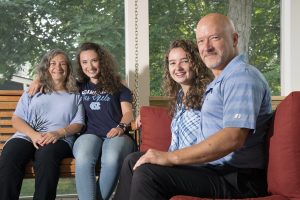
“They’re a little competitive when they play,” jokes Diane Youngstrom, who stands next to her sister Kay as they watch their parents from the porch of their family home in Chapel Hill.
A snap sounds, and Eric leans over the Carolina blue Ping-Pong table, extending his arm as far as possible to smack the ball back toward his wife, Jen, who laughs. The girls launch into a story about how their parents met in college and, after moving in together in graduate school, the only surface in their house was a Ping-Pong table, which they would cover with a tablecloth for meals.
“Mom is better than dad,” Diane whispers.
Table tennis isn’t the only tradition in the Youngstrom home. Science is another. The family has spent numerous meals around their real kitchen table, tossing around all sorts of topics from bipolar disorder, to sleep science, to global health care access. Just another game — and science is the ball.
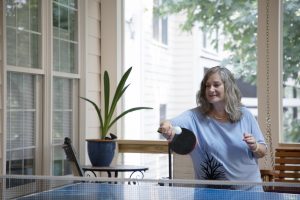
The Youngstroms are a family of researchers, and they have lived in Chapel Hill since 2006, when Eric and Jen took a faculty positions in the Department of Psychology and Neuroscience. While Eric focuses on developing assessment tools for bipolar and mood disorders, Jen works to apply that knowledge as a clinical psychologist within the UNC Psychology and Neuroscience Community Clinic.
“Jen’s my reality fairy,” Eric jokes. “She’s the person who makes sure my research works in the real world.”
They’ve co-authored about 50 papers and have presented their work together at more than 100 conferences. And their daughters are just as engaged in their own research endeavors.
Diane recently graduated from UNC with highest honors in chemistry and just began a new job as a neuroscience researcher at the National Institute of Environmental Health Sciences. Kay, a chemistry and statistics double-major, is entering her junior year and is actively engaged in two projects: one focuses on alleviating the auditory deficiencies experienced by people with autism and the other addresses the legal and ethical barriers of enrolling adolescents in HIV research.
While Diane and Kay’s research interests sometimes collide with their parents’, their ultimate goals are vastly different. Diane is fascinated by basic science and spent her last few years at UNC working in a traditional wet lab analyzing proteins within the tissue of brain models of Alzheimer’s disease. Most recently, Kay has been doing statistical analysis for Med Aditus, a Triangle-based nonprofit focused on increasing access to high-quality affordable medicines in Sub-Saharan Africa.
“As Diane and I have grown up, we’ve blossomed into individual researchers — with different research interests from each other and our parents,” Kay shares. “I love bouncing ideas off each other. Sometimes they suggest angles to problems that I never would have thought to use. Our minds are all broadened by the intellectual conversations we have, which are often at dinner or in the car.”
Research talk
One of those conversations took place on Diane’s college tour in spring 2016, when the girls were about 15 and 17 years old. Diane and Kay asked their parents what they’d been teaching in their classes. Eric explained that for several years he’d been giving out an extra credit survey with questions about personality, creativity, and mood to both students at UNC and Korea University — and that he felt he had enough responses to start looking at statistical trends.
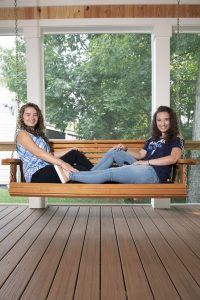
“And then the girls started asking questions,” Eric says. “So I grabbed a napkin and began jotting stuff down.”
At this time, the Youngstroms had spent seven summers in South Korea, where Eric and Jen teach psychology courses at Korea University. With years of cultural experiences under their belt, Diane and Kay helped Eric and Jennifer shape the questions into testable hypotheses during the car ride home to North Carolina. Then, Eric ran the analyses and printed out the results — most of which were the opposite of what the Youngstroms had predicted.
Together, the entire family developed and co-authored a series of posters — each one covering a different topic including mental health stigma, depression and suicide, and mood disorders — to display at the North Carolina Psychological Association conference. The following year, Kay and Diane replicated the results, which Kay presented at a national conference in New York City.
“Dad definitely did not toss us a bone to make this an easy research experience,” Kay says. “He made us work for it. But it was interesting to see and apply the knowledge of how we, as outsiders, observed South Korea throughout the years.”
“It was fun to take those observations that we thought we were having and try to quantify them scientifically,” Diane says. “That was kind of my first taste of research — diving into that data set with my dad, him guiding me through the hypotheses and data collection, using stats programs to analyze it, and then presenting that information. It was a beautiful arc and made me hungry for more.”
Lab allure
While Diane enjoyed working on the psychology surveys, she discovered a love for chemistry and wet labs after taking a class in high school — and decided to major in the subject at UNC. In 2018, the summer after her first year of college, she returned to South Korea with her parents to intern in a neuroscience lab at Seoul National University, where she began staining human brain tissue to identify proteins in the cells.
“That was really cool,” says Diane, chuckling.
After returning to Carolina, Diane joined the Child Imaging Research on Cognition and Life Experiences (CIRCLE) Lab ran by UNC psychologist Margaret Sheridan. She began working on the Youth Emotion Study, a research project exploring how stressful life experiences affect brain development in adolescent girls.
“Have you ever watched ‘CSI’ and seen those full, beautiful, rainbow-y brain images? Well I got a taste of how that works behind the scenes — and it takes months to build that image, called an fMRI,” Diane says. “It’s a lot of data processing, and I helped with that.”
But, like before, she missed the wet lab. And, like the agents in CSI, began doing some sleuthing of her own. After spending some time peeling through faculty web pages, she stumbled upon the lab of Graham Diering, a sleep and neuroscience researcher at UNC, and emailed him to learn more about his work. By the end of their first meeting, he offered Diane a spot in his lab.
Diane spent her last two years at Carolina studying how sleep disruption in early life contributes to brain diseases like Alzheimer’s. Using cell cultures, she created models of the inflammation found in the brains of patients with the disease, observing the various protein changes that occur to try to pinpoint the events that reduce learning and memory. She has also helped with experiments looking at how neurons communicate and how brain chemistry changes during sleep deprivation.
Global perspective
While Kay is also a chemistry major, her research goals differ from Diane’s and have been largely shaped by her family’s travels. Beyond South Korea, she’s visited more than 40 other countries.
“I have had the unique experience of seeing some of the best and some of the worst medical systems in the world,” Kay says. “And I think that what I want to do is take some of the best aspects from all these different systems and try to improve access to quality medical care.”
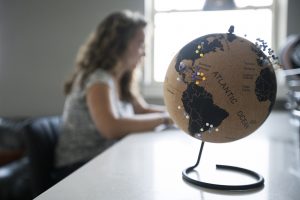
After stepping on a rusty nail while visiting India’s Ellora Caves when she was just 6 years old, Kay remembers watching her parents’ response. They debated seeking care at a local hospital because of the unpredictability of India’s health care system. Since Kay’s Tetanus shot was up to date, they decided to remove the nail, sterilize the wound, and bandage the foot themselves and would visit a doctor when they returned to the states.
“I completely understand their decision,” says Kay, now 20. “They didn’t know what good medical practice looks like in India, and it makes sense not to take the risk.”
This was the first of many difficult health care decisions the Youngstroms have had to make abroad. A decade later, Jen was bitten by an unvaccinated dog in Peru. Rabies treatment requires five shots, and each of the local clinics they visited only had one. Given that rabies is fatal and there had been an outbreak in that area of Peru in recent years, they worked with their tour company to find the five doses. They managed to collect them from several clinics, got a cooler to keep them refrigerated between destinations, and self-administered each dose every few days throughout the trip.
Later, in South Korea, Jen experienced an allergic reaction that required multiple cortisone shots and 14 different pills a day to treat. But this time she had almost immediate access to medical translators, a variety of specialists, top-of-the-line treatment, and a pharmacy to access it — all of which cost less than the deductible for their traveler’s insurance.
By the time Kay entered high school, she already had a deep interest in drug discovery and development to help improve lives around the world. This feeling was confirmed the summer after her sophomore year. She spent that summer, and the one after, working in different pharmaceutical research labs at Ewha Womans University in Seoul. She learned how to analyze data, detect proteins in cell cultures, and edit manuscripts for publication.
When Kay was ready to apply to college, she knew that she wanted to major in chemistry and received an unbeatable offer from Carolina: a scholarship from the Chancellor’s Science Scholars Program — which introduces undergraduates to research early on in their academic career — and acceptance into the Eshelman School of Pharmacy’s Doctor of Pharmacy program.
Now, Kay is deeply engaged in a variety of research projects, from a traditional lab using mouse models to identify auditory deficiencies in people with autism to a pharmaceutical company focused on bringing drug manufacturing facilities to Sub-Saharan Africa.
“I knew from about my freshman year of high school that I was interested in drug discovery and development to help improve lives around the world,” Kay says. “I think the impact you can have from bringing a new drug to market or optimizing a drug is incredible when you think about it. Like how many lives you can touch by just one molecule.”
Humble brilliance
That passion for public service deeply resonates with each of the Youngstroms. Diane digs into the basic research needed to understand diseases, and Kay strives to create the medicines that improve them. Jen trains the next generation of clinicians in therapy and psychological assessment, and Eric works to make mental health assessments free and accessible to everyone through a nonprofit called Helping Give Away Psychological Science (HGAPS). He won the Beckman Award for this work in December 2020 and donated the entire $25,000 award to HGAPS.
All of these goals are made possible, they say, thanks to the incredible support they have at home.
“My family is not afraid to critique each other’s ideas, which is super useful,” Kay shares. “We learn so much from each other.”
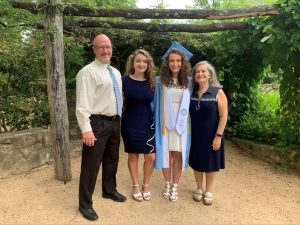
“I guess the apple doesn’t fall far from the tree,” Diane says, with a laugh. “I think Kay and I kind of forged our own paths, but our parents are so supportive. Whatever I am interested in, they try to find ways to help make that possible, and it’s definitely been so wonderful to have them at Carolina.”
Eric and Jen feel the same — and are impressed by their daughters’ drive.
“Both Diane and Kay are self-motivated, strong, independent thinkers and team players,” Jen shares.
“I don’t know where they get it,” Eric admits. “I was incredibly proud at Diane’s thesis defense. Getting highest honor in chemistry is no joke.”
The entire Carolina community, according to the Youngstroms, mirrors the kindness, collaboration, and hard work their family holds dear — extending their research family far beyond the walls of their home.
“We have a culture of humble brilliance within our researchers, our faculty, and our students that is unique to Carolina,” Kay says. “Everyone genuinely wants to collaborate and work together so we advance our research goals — and I love that.”
Eric Youngstrom is a professor in the Department of Psychology and Neuroscience within the UNC College of Arts & Sciences.
Jennifer Youngstrom is a clinical professor in the Department of Psychology and Neuroscience within the UNC College of Arts & Sciences and director of clinical services within the UNC Psychology and Neuroscience Community Clinic.
Diane Youngstrom is a UNC alumna who graduated with highest honors in 2021 with a dual degree in chemistry and neuroscience with a minor in statistics. She currently works as a researcher at the National Institute of Environmental Health Sciences in Durham, North Carolina.
Kay Youngstrom is a junior double-majoring in chemistry and statistics and analytics and minoring in neuroscience within the UNC College of Arts & Sciences. She is also a Chancellor’s Science Scholar.
By Alyssa LaFaro, Endeavors
